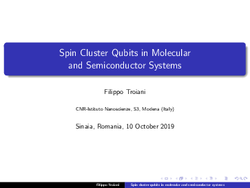June 2022 Denver, Co, USA.
Spin qubits on semiconductors: from fundamentals to the way of scale-up
18 January 2022 Online streaming.
Electronic Design at Low Temperature,” Workshop presentation at IEEE Quantum Week on “Closing the temperature gap between spin-qubits and their control electronics
October 2021 Denver, Co, USA.
The IQubits project for quantum computing in Si and SiGe MOSFETs
September 2021 Online streaming.
Unique Features that Make FDSOI CMOS Ideal for Millimetre-Wave and Quantum Computing Applications”
September 2021 IEEE EuroSOI Conference 2021, Caen, France (Virtual).
Hole spin qubits in Si and Ge quantum dots: Ultrafast gates and noise resilient qubits
July 2021 Online streaming
Testing requirements for emerging single-chip cryogenic mixed-signal quantum processors in production FDSOI CMOS technology
June 2021 IEEE RFIC 2021(Virtual)
Architectures, Cryogenic Technology Characterization and Design Methodology for Scalable mm-Wave Monolithic QPs with Integrated Control Electronics
June 2021 IceQubes (Virtual)
Collaborative research in advanced devices for future electronics
November 2020 National Seminar of Nanotechnology (Virtual).
Control of Semiconductor Spin Qubits
September 2020 IEEE ESSCIRC 2021.

Silicon Spin Qubit Control and Readout Circuits in 22nm FDSOI CMOS
14 October 2020 Invited paper - Special Session on The Art of Building Large-Scale Quantum Computers: From Physics to Engineering - IEEE International Symposium on Circuits and Systems, Sevilla, Spain
Towards Monolithic Quantum Processors in Production FDSOI CMOS Technology
12 December 2019 Invited lecture at the IEEE Circuits and Systems Society Santa Clara Valley Chapter, Santa Clara, CA, USA

Towards Monolithic Quantum Processors in Production FDSOI CMOS Technology
15 November 2019 Invited talk at the IEEE Microwave Theory and Technique Society Chapter, Irvine, CA, USA

Testing Requirements for Emerging Single-Chip Cryogenic Mixed-Signal Quantum Processors in Production 22nm FDSOI CMOS Technology
14 November 2019 Invited talk at the International Symposium for Testing and Failure Analysis 2019, Portland, OR, USA
Quantum supremacy with a superconducting processor
11 November 2019 IQubits Seminar Series, University of Modena and Reggio Emilia, Modena, Italy
Towards Monolithic Quantum Processors in Production FDSOI CMOS Technology
10 November 2019 Invited plenary talk at IEEE International Semiconductor Conference 2019, Sinaia, Romania

Millimeter-Wave Integrated Silicon Devices: Active versus Passive - The Eternal Struggle Between Good and Evil
11 October 2019 Invited plenary presentation at IEEE International Semiconductor Conference 2019, Sinaia, Romania

Spin Cluster Qubits in Molecular and Semiconductor Systems
10 October 2019
Epitaxy and polarization engineering for future III-Nitride heterostructure devices
09 October 2019 Invited plenary presentation at IEEE International Semiconductor Conference 2019, Sinaia, Romania
Towards Monolithic Quantum Processors in Production FDSOI CMOS Technology
27 September 2019 STMicroelectronics, Crolles, France
Towards Monolithic Quantum Processors in Production FDSOI CMOS Technology
23 September 2019 Short course talk at IEEE European Solid-State Circuits Conference 2019, Krakow, Poland

Engineering Solid-State Qubits Structures for High-Temperature Silicon Quantum Computing Through Multi-Scale Simulations
09 September 2019 Italian Quantum Information Science Conference 2019, Milan, Italy

Towards 2-4 K monolithic quantum processors with control and readout electronics in production 22nm FDSOI CMOS technology
19 June 2019 Invited talk at the Workshop on Cryogenic Electronics for Quantum Computing, FermiLab, Batavia, IL, USA

Design Considerations for Spin Readout Amplifiers in Monolithically Integrated Semiconductor Quantum Processors
03 June 2019 Venue: IEEE Radiofrequency Integrated Circuits Symposium, Boston, MA, USA
Towards Monolithic Quantum Processors in Production FDSOI CMOS Technology
02 May 2019 GlobalFoundries, Malta, NY, USA

Si-Based Transistor and Analog-Mixed-Signal Circuit Scaling and the Natural Progression of Moore's Law to Silicon Quantum Computing at the Atomic Scale
14 August 2017 IEEE Solid-State Circuits Society Distinguished Lecture at Aarhus University, Denmark